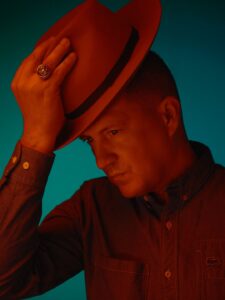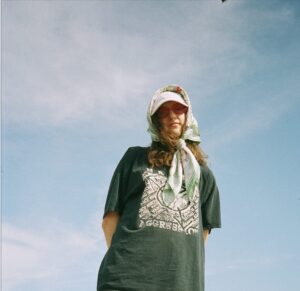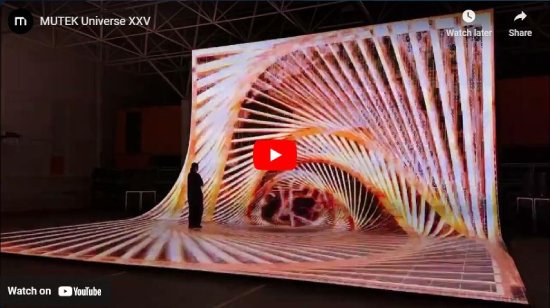For its 25th Anniversary, the MUTEK festival is sticking to what it’s always done best: champion the daring work of local and international electronic music and digital artists. The event’s history is a testament to Montréal’s’ vibrant electronic scene since its inception over three decades ago.

Alain Mongeau. Photo: Petronille Gontaud
After being one of the world’s main hubs for disco in the ’70s and new wave ion the ’80s, Montréal started pulsating to the harder rhythms of acid house and techno in the early ’90s. All over the city’s underground, young people were re-appropriating lofts and warehouses, and other abandoned premises, to dance frenetically from sundown to sunup. Local rave culture, influenced by both the American and European ones, started taking root here.
This is where our story begins: Alain Mongeau, who would go on to create MUTEK, was enthralled to discover this new culture. “Initially, it was mostly Anglophone insider, especially British people, who attended raves,” he says. “There was no critical mass of people who were into that. It was a closed circuit… until it reached the Francophone crowds.”
Hailing from Québec City, DJ, producer and record label owner Fred Everything – who’ll appear live for a second time during this year’s edition of MUTEK – was privy to the early stages of this effervescence. “That whole acid house scene in England really spoke to me,” he says. “It was dance music, but with an alternative side with which I could identify.”
Almost obsessively, the artist, still in his teens, started going to the various clubs and raves in Québec City, and made trips to Montréal to attend larger-scale events. He was there, in March 1993, for one of the first “official” raves to be held in the city: Solstice, organized by one of the Montréal electronic scene’s central figures, Tiga. “It happened in the old Museum of Contemporary Art, located next to Habitat 67. Buses were charted from all over the place to get there!” he remembers, with a tinge of nostalgia.
Initially fascinated by this nascent culture, Alain Mongeau noticed that the phenomenon was slowly being commercialized around the mid-‘90s, and this trend slightly tarnished the positive image he had of raves. “What I liked about rave culture wasn’t just the music, but also its environment, and the discovery aspect of it,” he says. “Those events had a very strong immersive component to them, thanks to their light shows and visuals. But when the after-hours clubs started popping up, it was like being back in a club. The commercial powers that be co-opted the movement. We’d lost the creative, free aspect of it.

Fred Everything. Photo: Bruno Destombes
“Part of the problem was that organizing illegal parties wasn’t always easy,” explains Fred Everything, from a slightly more optimistic perspective. “We were tired of having to fight the police, or constantly being on the hunt for a new venue [for the raves]… That’s why a more sustainable business model took hold.”
But by that time, Mongeau had already moved on. In 1994, he attended the Interference festival, a visionary event organized in parallel with Berlin’s famous Love Parade. That’s where the young thirtysomething had an epiphany. “It was the first time I attended an event that focused on the artistic side of electronic music,” he says. “It was way beyond the mere festive aspect of that music. You could tell everyone was trying to earn this artistic expression it’s letters of nobility.”
A few years later, Mongeau created MUTEK with the same mission: to preserve and foster Québec’s creative fount of electronic music and digital arts. One of the approaches he favoured was to ask the artists invited to his festival to play live instead of playing a DJ set. Even today, according to Mongeau, 99.9% of the artists featured in any given edition present live performances, in keeping with the spirit of the Interference model.
The 2000s Slump and the 2010s Renaissance
After a memorable first edition featuring 30 artists – including Tim Hecker, now internationally known for his ambient, drone, and noise explorations – MUTEK carved out a choice place for itself in the North American electronic events circuit. Throughout the 2000s, leading local musicians such as Akufen and Scott Montieth, as well as digital artists such as Herman Kolgen, Myriam Bleau, and Martin Messier, saw their careers develop in parallel with the growth of the festival. “The problem is, after a few years, many of them moved to Europe because of the limiting North American context,” says Mongeau.
Why? Markets with an appetite for electronic music are much closer to one another over there, and opportunities for these artists to perform are proportionally more frequent and numerous. Which is why Fred Everything fled the local scene in the 2000s. After establishing himself as a key player in Montréal’s scene around the turn of the millennium – thanks to his unique blend of house, techno and jungle – he moved to San Francisco, and lived there for about seven years. “I’d hit the ceiling of what’s possible in Montréal,” he says. “I felt a lack of inspiration. I needed to be in a more vibrant environment, culturally.”

Maara
But when he returned to Montréal in 2015, he was pleasantly surprised to see that the electronic scene had grown much stronger. “Just before leaving, I’d played a DJ set during Piknic Électronik’s second edition and there were maybe 80 people, counting the staff,” he says. “When I came back, it was absolutely insane! MUTEK, too, had become a major destination, and not just for Montrealers. There was also a whole, very vibrant scene around Mile End, with artists like Jacques Greene and Pablo Project.”
Producer Maara decided to immerse herself in that ebullient scene. After growing up in the U.S. and Toronto, the Montréal-born artist – then known as Massie Dome – returned to her hometown in the mid-2010 as a young adult, and latched on to this highly stimulating artistic environment. “I was going to bars and parties on Durocher Avenue, making DJ friends,” she says, mentioning names such as Lis Dalton, Ex-Terrestrial, Ramzi, and Bootyspoon, among others. “I felt really lucky. It was a very special time in Montréal’s nightlife.”
By then, MUTEK was firmly rooted as a beacon of electronic music. “My big sister took me to the festival when I was 18,” says Maara. “It was insane to see the degree of integration between the music and light shows. I really enjoy the festival’s artistic approach. And as festivals go, it’s way less commercial than Montréal’s other major events. You can definitely feel a buzz when MUTEK starts every year.”
Shortly after moving back to Montréal, Maara officially launched herself as a producer and DJ. She was welcomed by the scene, thanks to her energetic and intentionally chaotic blend of dance, trance, and progressive house. But shortly after it burgeoned in 2017, Maara could tell that there was a shift in the city’s dynamics. “The scene got colder at the beginning of the pandemic,” she says. “We lost a lot of underground parties and we had to slowly rebuild all of it.”
Beyond the major figures to have emerged from the Montréal scene – the likes of Priori, Marie Davidson, and Kaytranada, for example – it still remains a modest one on the global scale. “Montréal isn’t a production powerhouse, as is Melbourne’s scene, for example,” says Maara. “I wouldn’t say it’s the most important city in the world for dance music, but ironically, I also think that’s what makes it so special. There’s room for innovation and creativity because the city isn’t at the heart of everything. That allows artists to grow without any pressure to conform to a sound. Montréal doesn’t force artists to be successful or to commercialize what they do.”
That’s why MUTEK has established itself as the best channel to promote our electronic music scene. In addition to its annual Montréal event, the festival now exports Canadian music through its international satellites in Mexico City, Barcelona, Buenos Aires, Santiago, Tokyo, and Dubai. On the other hand, big names from all over the world flock to the city every summer to perform during the festival. This year, revellers will have a chance to catch, among many others, Nosaj Thing, Kode9, and Steffi onstage.
“One of the main aspects of remaining relevant as a festival is to grow and evolve at the same pace as the artists and artistic movements,” says Mongeau. “Never letting yourself get left behind, and constantly keeping up with what’s going on, is a full-time job.”
A quarter-century after its creation, MUTEK is still meeting this challenge with flying colours.
